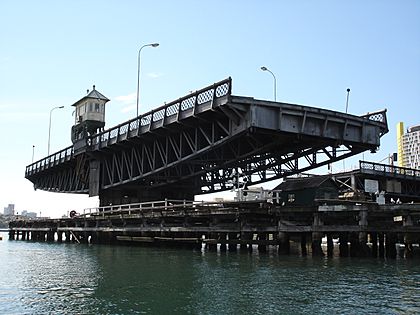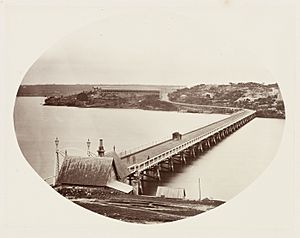Glebe Island Bridge facts for kids
Quick facts for kids Glebe Island Bridge |
|
|---|---|

Glebe Island Bridge in a permanently open position
|
|
| Coordinates | 33°52′06″S 151°11′09″E / 33.8682°S 151.1857°E |
| Carries | Bank Street |
| Crosses | Rozelle Bay |
| Locale | Rozelle – Pyrmont, Sydney, New South Wales, Australia |
| Maintained by | Roads & Maritime Services |
| Preceded by | Anzac Bridge |
| Followed by | Sydney Harbour Bridge |
| Characteristics | |
| Design | Swing Allan truss |
| Material | Steel |
| Trough construction | Timber |
| Total length | 108 metres (353 ft 6 in) |
| Width | 15 metres (50 ft) |
| Height | 6 metres (20 ft) |
| Longest span | 58 metres (191 ft) |
| Number of spans | 3 |
| History | |
| Engineering design by |
|
| Constructed by | H. McKenzie and Sons |
| Construction begin | 1899 |
| Construction end | 1903 |
| Opened | 1 July 1903 |
| Closed | 2 December 1995 |
| Replaces | Blackbutts Bridge (1862–1903) |
| Official name | Glebe Island Bridge; RMS Bridge No. 61 |
| Type | State heritage (built) |
| Designated | 29 November 2013 |
| Reference no. | 1914 |
| Type | Road Bridge |
| Category | Transport - Land |
| Builders | Bridges Branch of NSW Public Works Department |
| Official name | Glebe Island Bridge, Bank St, Pyrmont, NSW, Australia |
| Type | Historic |
| Designated | 19 April 1989 |
| Reference no. | 15949 |
The Glebe Island Bridge is a special road bridge in Sydney, Australia. It's called a swing bridge because a part of it can turn to let boats pass. This bridge used to carry traffic across Rozelle Bay, connecting the areas of Rozelle and Pyrmont.
It was designed by Percy Allan and built between 1899 and 1903. The Glebe Island Bridge is one of the last swing bridges of its kind left in Australia and even the world! It is now a heritage-listed site, meaning it's protected because of its historical importance.
Bridge History in Sydney
Sydney became a city in 1842. In the mid-1800s, it was a busy place with shops, homes, and factories. People needed better ways to travel out of the city. A shorter route was found across Johnstons Bay to Glebe Island and then to Annandale.
First Glebe Island Bridge
The very first Glebe Island Bridge was a private bridge finished in 1862. It was made of timber and had a small, hand-cranked swing part near the Pyrmont side. After 30 years, this bridge needed a lot of repairs. The government bought it, and the Public Works Department started planning a new one. This first bridge opened for traffic in 1861.
Second Glebe Island Bridge
The second bridge was part of a bigger plan from the 1880s called the "Five Bridges Route." This plan aimed to make it easier for traffic to get from the city to the northern and western suburbs. Before these bridges, people had to use boats or long roads to cross the harbour.
New bridges were built at Gladesville (1881), Iron Cove (1882), and Fig Tree (1885). Then, attention turned to replacing the Pyrmont and Glebe Island Bridges. In 1890, experts suggested building new bridges similar to the Pyrmont Bridge.
There were different ideas about the best way to build the new bridges. Some thought timber bridges would be cheaper. Finally, in 1897, it was decided to replace the old Glebe Island Bridge with a stone causeway and a bridge with a steel swing-span.
Designing the Third Bridge
The design of the new bridges was led by Percy Allan, a famous bridge designer. His team included Ernest de Burgh and J. J. Bradfield, who later designed the Sydney Harbour Bridge.
Percy Allan designed an electrically-operated swing bridge for both locations. This was very new and exciting at the time, as it was the first time electricity was used for this purpose in Australia. The designs were so innovative that they got attention from around the world.
Building the Current Bridge
Building the Glebe Island Bridge started at the same time as the new Pyrmont Bridge. The Glebe Island project was bigger because it needed more land and a lot of work to create a raised road (causeway) across Glebe Island. Over 10,000 tonnes (about 11,000 US tons) of mud were removed from the bay.
The new bridge used strong steel parts for its approaches, unlike the Pyrmont Bridge which used timber. This was Percy Allan's original idea for both bridges. The company H. McKenzie and Sons built the bridge.
The Glebe Island Bridge officially opened on July 1, 1903. Miss Lily See, the daughter of the Premier of New South Wales, Sir John See, opened it. It opened just one year after the new Pyrmont Bridge, which had a similar design.
Bridge Operations and Changes
The Glebe Island Bridge worked well from 1903 until 1995. It only needed regular maintenance and a few upgrades. In 1933, its underwater supports were strengthened. In 1961, the old electricity supply from the tram system was shut down. A new power supply was installed. In the 1980s, the control room caught fire and was rebuilt.
The bridge could swing open in just 44 seconds, which was very fast for bridges at that time. Traffic was controlled by lights and gates. These gates made sure the bridge couldn't open until all cars and people were safely off.
In 1995, the bridge was closed to traffic. This happened because the new Anzac Bridge opened nearby, making the Glebe Island Bridge no longer needed for cars. Since then, it has stayed in an open position. It was used by cyclists for an event until 2008.
In 2009, a check found the bridge was in "very poor condition." By 2013, it had gotten worse. Many people want the bridge to be fixed and reopened for walkers and cyclists. There's even an idea to use it for the Inner West Light Rail in the future.
Bridge Features
The Glebe Island Bridge is an electrically-operated, low-level bridge made of steel. Its main part is a central swing-span. This part sits on a huge central pillar, which allows it to spin 90 degrees. This lets boats pass through the waterway.
The parts of the bridge leading up to the swing-span are made of steel and sit on stone pillars. The bridge also has built-up roads (embankments) on both sides of its western approach.
The bridge has two approach spans, each about 24.7 meters (81 feet) long. The two main swing spans are about 29.3 meters (96 feet) long each. The total length of the bridge is about 108 meters (354 feet). The road is 12.2 meters (40 feet) wide, and there are footpaths on each side, each 1.5 meters (5 feet) wide.
The central pillar in the water is protected by many timber poles. The swing part of the bridge moves using a 600-volt electric motor.
The bridge also has a rare Mercury-arc Rectifier. This is an old electrical device that helped power the bridge. It's now very rare and mostly found in museums.
The Glebe Island Bridge and the Pyrmont Bridge were both designed by Percy Allan. They are similar but have some differences. For example, the Glebe Island Bridge uses more steel, while the Pyrmont Bridge uses more timber for its fixed parts.
Bridge Condition
In December 1995, when the bridge closed, it was in good condition. However, since then, it has not had much maintenance. It has been left with its swing part open. Because of this, it now needs a lot of repairs and maintenance work. Even so, the Glebe Island Bridge is still mostly in its original form from when it closed in 1995.
Bridge Changes Over Time
- 1936 – The supports at the ends of the bridge were strengthened.
- 1944 – A stairway was built to the control room.
- 1955 – The tram tracks and wood blocks were replaced with bitumen (a type of asphalt).
- 1959 – Electrical changes were made when a new power company supplied electricity.
- 1982 – The bridge's control room was destroyed by fire and rebuilt with modern electrical systems.
Other small changes included updates to traffic lights and signs.
Why the Bridge is Important
The Glebe Island Bridge is very important to the history of New South Wales. It shows one of the earliest examples of an electric-powered swing bridge in Australia. It's like a twin to the famous Pyrmont Swing Bridge, and both were designed by the highly respected engineer Percy Allan. These two bridges are the only large, electrically-operated swing bridges left in Australia.
The bridge played a big role in Sydney's history for over 90 years. It was a key part of the "five bridges" route, helping people travel from the city to the northern and western suburbs. Its history is linked to how Sydney grew and developed in the late 1800s.
Important People Connected to the Bridge
The Glebe Island Bridge is important because of its connection to Percy Allan (1861-1930). He was a very important Australian bridge designer. He designed over 500 bridges in New South Wales! The bridge is also linked to J. J. C. Bradfield (1867-1943), who later became famous for his work on the Sydney Harbour Bridge.
The bridge also represents the great work of the NSW Department of Public Works, a very important organization in the history of New South Wales.
Technical Achievements
The design and building of the Glebe Island Bridge were a huge technical achievement for its time. Its innovative design included:
- The large size of its swing span and how fast it could open.
- The way its steel parts were built.
- The special way its foundations were constructed.
- The use of electric power to operate it.
The bridge's design shows the best engineering and material technology of the late 1800s. It's also a beautiful and impressive structure in Sydney Harbour, making it a landmark that can be seen from many places.
Community Value
The people of Sydney value the Glebe Island Bridge. It helped Sydney and its inner western suburbs grow socially and commercially. Many people want to see it preserved, showing how much the community cares about it.
Learning from the Bridge
The bridge is a great example of technology from the late 1800s and early 1900s. It is almost completely in its original condition. The way its structure, mechanics, and electrical systems work together made it a perfect example of good bridge building for its time. It can still teach us a lot about engineering history.
Rarity of the Bridge
The Glebe Island Bridge is rare because it's one of only two electrically-operated steel swing bridges in New South Wales. It's the second oldest surviving bridge across a Sydney Harbour waterway, after its "twin," the Pyrmont Bridge.
It also has a rare Mercury-arc Rectifier, an old electrical technology. These are now very rare outside of museums. The bridge is important because it shows all the main features of a swing-span bridge. These types of bridges were a smart solution for building roads over waterways where tall bridges were too expensive. They were very important for the economic growth of New South Wales.



